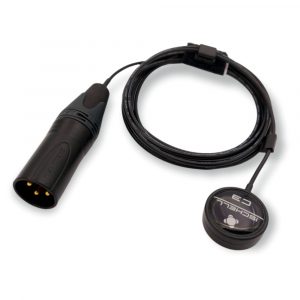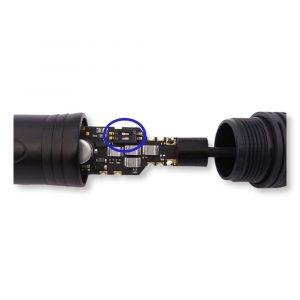C3BHP

 Model C3BHP
Model C3BHP
ISCHELL Pickups
Thank you for purchasing a system ISCHELL. We are delighted to welcome you to the growing number of world-renowned music, technician, audio engineers and artist users who have chosen to use our systems.
We are at your disposal and we will always remain so over time, for any question relating to the use of our systems on your instrument. Your complete satisfaction is a priority for us. Consult the online help and contact us if you cannot find the solution to your problem.
- The model C3BHP is equipped with the contact microphone C3 developed by the brand ISCHELL since 2008 in order to reproduce with the greatest fidelity the acoustics of your instrument, the attack, the timbre, the woody color, your playing and your playing nuances, without feedback problems and without picking up the sounds around you. Our hybrid Air / Contact technology works without a filter between the membrane and the soundboard of your instrument. We thus reproduce on a reduced and isolated scale an aerial sound recording, controlled by the immediate environment of our specific putty audio adhesive.
- The sound is comparable to an aerial microphone, fidelity, warmth, width, air… With the acoustic insulation and the feedback resistance of a cell allowing high levels face / returns. You can easily use it in an amp, apply effects or make clean loops. A revolution in the amplification of many instruments on stage! An innovation ISCHELL !
- All our products are manufactured and assembled in France by hand, with awareness and respect for a job well done, only with high quality components, for products that we hope will bring you satisfaction for many years on stage, in the studio and at each of your performances amplified.
- You made the right choice, the model C3BHP is easy to use, it works on phantom power from 9 to 48 volts and adapts to many instruments.
- We strongly recommend that you take a few minutes to read this manual. Indeed, it is important to respect a few principles in order to benefit simply and quickly from these new systems.
What you need to know !
- Always unplug your instrument before attempting placement again or changing the low cut.
- Wash your hands before kneading the putty and carefully clean the bonding areas before doing your tests, they must be dry, non-greasy, clean and smooth.
- You will find two doses of audio adhesive putty with your system. A white and a gray, they do not have the same sound.
- Carefully read the instructions for preparing the various contact microphones and those relating to positioning on your instrument in this knowledge base.
- C2 and C3 contact microphones preparation page
- Use only the audio adhesive putty ISCHELL ! Any other putty will distort the quality of the sound.
- Please note: The microphone is held on the instrument thanks to the adhesive putty. Make sure that the microphone will not detach from your instrument during use, its detachment would generate enormous feedback.
- This system requires 9v to 48v phantom power to operate.
- Operate delicately to act on the low cut. A small pointed object is needed to operate the switches.
- The use of the low cut is not compulsory and depends on the instruments. The 360Hz cut-off is the default position for acoustic instruments, your system is delivered to you in this position. However, if after finding the best mic placement you lack bass width, then try 180Hz, mid position, or Flat for full bandwidth.
- This system is like your instrument, it is fragile. Never pull on the cables, always remove the microphone gently from your instrument by taking it by the shell and gently rocking it while removing the putty, to avoid a too sudden suction effect for the membrane which is fragile and to preserve the surface of your instrument.
Low cut

- Open the XLR as pictured by holding the barrel with your left hand and twisting the cover to open it.
- A small switch inside the XLR allows three bass cut positions, 360Hz, 180Hz and Flat. It is circled in blue in the photo.
- The two switches on the left cut the bass below 360Hz, this is the maximum cut.
- To have all the bandwidth, in Flat mode, put the lower switch on the right, the upper one remains on the left.
- The 180Hz position is obtained by putting the top switch on the right, the bottom one remains on the left.
- A drawing represents these positions on the XLR
- Then replace the circuit in the was, turn it to find the place where it will sink completely then close the cover, for that, present it, turn in the opposite direction of closing until a small notch, then then turn in the closing direction, without forcing too much. If it forces too much, the cover is not properly in place, repeat this procedure.
Features
- System C3BHP
- Contact microphone C3
- High resistance to feedback
- Strong sound insulation
- Wide bandwidth: 20 / 20000Hz
- Flat frequency response curve with a slight bump in the treble
- High performance sensitivity and signal-to-noise ratio
- Cable length between microphone and XLR: 220 cm
- Cable diameter 2mm
- Balanced XLR output
- audio adhesive putty for contact microphone Ischell provided
- Microphone dimensions: Height 12/13 mm with the putty - Diameter: approximately 25 mm
- Online user manual
- Semi-rigid storage case
After-Sales Service

- Our products are guaranteed against any manufacturing defect for 2 years from the date of purchase.
- We are at your disposal and we will always remain so in time for any question relating to the use of our systems on your instrument.
- Your complete satisfaction is a priority for us. Consult the online help and contact us if you cannot find the solution to your problem.
- Refer to the CGV on www.ischell.com for more information on the warranty.
Contact
ISCHELL MICROPHONES 119 impasse de la gare – 44800 Saint-Herblain – FRANCE
Tel: +33 (0)6 62 09 54 91 – Email: info@ischell.com

